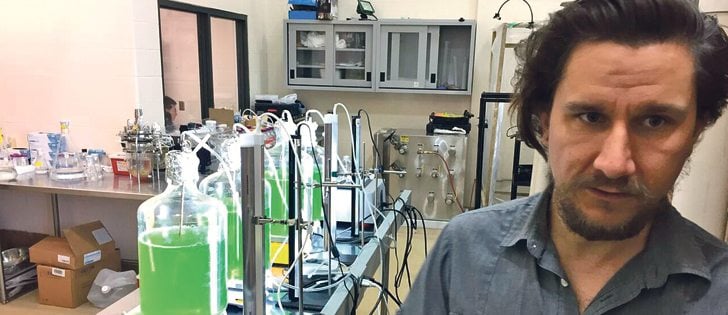Fish poop and green algae might help farms grow without having to expand.
That’s the hope for developers of an integrated farming system that could combine grain, fish and algae in a self-sustaining circle.
“Molecular farming is a really good option,” Bruce Hardy, president of Myera Group, said during a tour of its laboratory-farm at the University of Manitoba’s Richardson Centre for Functional Foods and Nutraceuticals.
“We’re really open to participating with anyone.”
Hardy algae research scientist Ryan Sestric has been developing a looped production system that could operate inside an existing grain farm, local municipality or a First Nation.
It’s called “molecular farming” because valuable molecules can be produced and extracted at the end of the loop. However, a more complex process is required to get there.
First, an operation needs to install large water tanks to create a fish farm. This produces a valuable meat commodity, which by itself would help diversify a farm.
However, that would still leave the farmer in the bulk commodity business.
Adding an algae farm will boost the value-adding and make the system more efficient.
Read Also

Farming Smarter receives financial boost from Alberta government for potato research
Farming Smarter near Lethbridge got a boost to its research equipment, thanks to the Alberta government’s increase in funding for research associations.
Dirty fish water now becomes the primary feed source for specialized algae instead of a costly disposal problem. The algae consume the feed, grow and are harvested.
The algae types are specialized to produce specific substances, whether it be pharmaceuticals, nutraceuticals or micronutrients.
The algae is broken apart after being harvested to release the valuable substances, which produces a high-value, low-volume product.
The leftover algal waste can be fed to chickens, providing them with a good nutrition source.
“That’s a functional food egg,” Hardy said about those coming from algae-fed hens.
Large containers of a bright green solution bubbled away around Sestric and Hardy with the algae too small to see other than by their effect of dramatically colouring the water.
A series of tanks allows the algae to grow differently and be tested differently. The researchers have been experimenting with environmental changes to see how that affects algae growth and development.
The lab doesn’t raise fish. Instead, Sestric has been creating synthetic fish poop.
Hardy said his company has developed a “community innovation campus” west of Winnipeg where people interested in getting into the business can learn its tricks.
Hardy said these sorts of production systems would be perfect for distant First Nations reserves where little fresh food is available and nutrient deficiencies exist.
They would also work well on a grain or other conventional farming operation to provide another stream of income, diversification and a way to expand without having to add acres.
Empty pregnant mare’s urine barns in southwestern Manitoba are proving to be popular places to add a fish farm.
Algae farms aren’t unique to Manitoba. Many grow in warmer places, but are much different. Those in the southwestern United States tend to be large and open to the environment. They are cheap to create and low-cost to operate.
However, that does not allow for carefully controlled production, so it would not work for the type of production that Sestric and Hardy are developing.
Sestric has worked with biofuel produced by algae, which is a “high volume, low value” substance. It couldn’t be easily made economically in the sort of system that has to be used in Western Canada, where the land is frozen for much of the year.
However, the much more expensive system they have developed is perfect for refined production of high-value molecules, Sestric said.
“It’s a pretty cool thing,” he said.
“We’re making a nutraceutical which is high value and the volume is less important.”


















